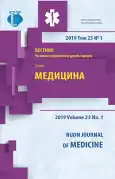THE MAIN CLINICAL SYNDROMES ASSOCIATED WITH ACTIVE CRONIC ATIPICAL EPSTEINE-BARR VIRUS INFECTION: CREATED ALGORITHM OF CLINICAL AND LABORATORY DIAGNOSTIC
- Авторлар: Nesterova I.V.1,2, Khalturina E.O.3,2
-
Мекемелер:
- Kuban State Medical University
- Clinical and diagnostic center MEDSI on Belorusskaya
- I.M. Sechenov First Moscow State Medical University, Moscow (Sechenov University)
- Шығарылым: Том 23, № 1 (2019)
- Беттер: 70-78
- Бөлім: IMMUNOLOGY. ALLERGOLOGY
- URL: https://journal-vniispk.ru/2313-0245/article/view/345305
- DOI: https://doi.org/10.22363/2313-0245-2019-23-1-70-78
- ID: 345305
Дәйексөз келтіру
Толық мәтін
Аннотация
The annual steady increase of the herpesviral infections number in the human population is one of the most important interdisciplinary problems of modern medicine. Clinicians and laboratory diagnostics physicians face difficulties in clinical symptoms assessing, inadequate laboratory diagnostics and difficulties in interpretation of the obtained results. This is connected with a low awareness of atypical chronic active infection symptoms caused in particular by the Epstein-Barr virus (EBV), of the ability to fully diagnose, and of serious consequencescaused by prolonged activity of herpesviruses in the human body. Studies were carried out to determinethe functioning features of the antiviral defense system, as well as defects and disorders in the interferon system in patients suffering from various mono-, mixed herpesvirus infections and bacterial co-infections. The main clinical syndromes associated with these herpetic infections, as well as prevailing nosological forms of concomitant diseases, have been identified. Among the group of patients suffering from mono-herpesvirus infections, the leading position takes the allergic syndrome (55%), while the syndrome of chronic fatigue syndrome (85%) and the infectious syndrome (68%) prevail in the incidence of patients with mixed herpesvirus infections. Extended testing of the antiviral protection main mechanisms state made it possible to identify the most frequent defects in the functioning of antiviral immunity: disturbances in induced production of IFNα and IFNγ, deficiency of cytotoxic T lymphocytes, deficiency of natural killer cells, including EKT, and / or inadequate absence of their activation, neutropenia. The revealed clinical syndromes and functioning features of the antiviral defense system will allow us to further develop the concept of complex, individualized, etio- and immunopathogenetic therapy.
Негізгі сөздер
Авторлар туралы
I. Nesterova
Kuban State Medical University; Clinical and diagnostic center MEDSI on Belorusskaya
Хат алмасуға жауапты Автор.
Email: inesterova1@yandex.ru
SPIN-код: 4714-2488
Krasnodar, Russia
E. Khalturina
I.M. Sechenov First Moscow State Medical University, Moscow (Sechenov University); Clinical and diagnostic center MEDSI on Belorusskaya
Email: inesterova1@yandex.ru
SPIN-код: 2813-4952
Moscow, Russia
Әдебиет тізімі
- Babcock J.G., Hochberg D., Thorley-Lawson A.D. The expression pattern of Epstein-Barr virus latent genes in vivo is dependent upon the differentiation stage of the infected B cell. Immunity. 2000.13: 497-506.
- Hislop A.D., Taylor G.S., Sauce D., Rickinson A.B. Cellular responses to viral infection in humans: lessons from Epstein-Barr virus. Annu Rev Immunol. 2007. 25. P. 587-617.
- Kuzushima K., Matsuoka H. Impaired cytotoxic T lymphocyte response to Epstein-Barr virus-infected NK cells in patients with severe chronic active EBV infection. J Med Virol. 2001.64:141-8.
- Lusso P. HHV-6 and the immune system: Mechanisms of immunomodulation and viral escape. J ClinVirol. 2006. 37(Suppl 1):S4-10.
- Merlo A., Turrini R., Dolcetti R., Martorelli D., Muraro E., Comoli P., Rosato A. The interplay between Epstein-Barr virus and the immune system: a rationale for adoptive cell therapy of EBV-related disorders. Haematologica. 2010. 95 (10). P. 1769-1777.
- Ning S. Innate immune modulation in EBV infection. Herpesviridae. 2010. 2 (1). P. 1.
- Pizzigallo Eligio, Racciatti Delia, and Gorgoretti Valeria. EBV Chronic Infections. Mediterr J Hematol Infect Dis. 2010. 2 (1).
- Randall R.E., Goodbourn S. Interferons and viruses: an interplay between induction, signalling, antiviral responses and virus countermeasures. J. Gen.Virol. 2008. 89. P. 1-47.
- Wu L., Fossum E., Joo C.H., Inn K.S., Shin Y.C., Johannsen E., Hutt-Fletcher L.M., Hass J., Jung J.U. Epstein-Barr virus LF2: an antagonist to type I interferon. J Virol. 2009. 83 (2). P. 1140-1146.
- Vorobiev A.A., Kiselevskiy M.V., Khalturina E.O. Immune system. Immunology. 2001. № 6. P. 15.
- Tracy S.I., Kalacheva K., Lunemann J.D., Luzuiaga K. et al. Persistence of Epstein-Barr virus in self-reactive memory B cells. J. Viorol. 2012. Vol. 88. № 22. P. 12330-12340.
- Olson D., Huntington M.K. Co-infections with cytomegalovirus and Epstein-Barr virus in mononucleosis: case report and review of literature. S D Med. 2009. V. 62. № 9. P. 351-353.
- Xia Wang et al. Coinfection with EBV/CMV and other respiratory agents in children with suspected infectious mononucleosis. Virol. J. 2010. V. 7. P. 247.
- Bravender T. Epstein-Barr virus, cytomegalovirus, and infectious mononucleosis. Adolesc. Med. State Art Rev. 2010. V. 21. № 2. P. 251-264.
- Ulish Е.I. Persistence infections and human: relationship strategy. Child health. 2009. № 4. P. 114-122.
- van de Berg P.J.E.J., Griffiths S.J., Yong S.-L., Macaulay R., Jackson S., Henson S.M., ten Berge I.J.M., Akbar A.N., van Lier A.W. Cytomegalovirus Infection Reduces Telomere. J. Immunol. 2010. 184:3417-3423.
- Poon S.S., Lansdorp P.M. Current Protocols in Cell Biology. 2001. 12:18.4:18.4.1-18.4.21.
- Fukumoto H., Kanno T., Hasegawa H., Katano H. Pathology of Kaposi’s sarcoma-associated herpesvirus infection. 2010. Front Microbiol 2: 175.
- Kutok J., Wang F. Spectrum of Epstein-Barr virus-associated diseases. Annu Rev Patholю 2006. P. 375-404.
- Levin L., Munger K., O’Reilly E., Falk K., Ascherio A. Primary infection with Epstein-Barr virus and risk of multiple sclerosis. AnnNeurol. 2010. 67: 824-830.
Қосымша файлдар









